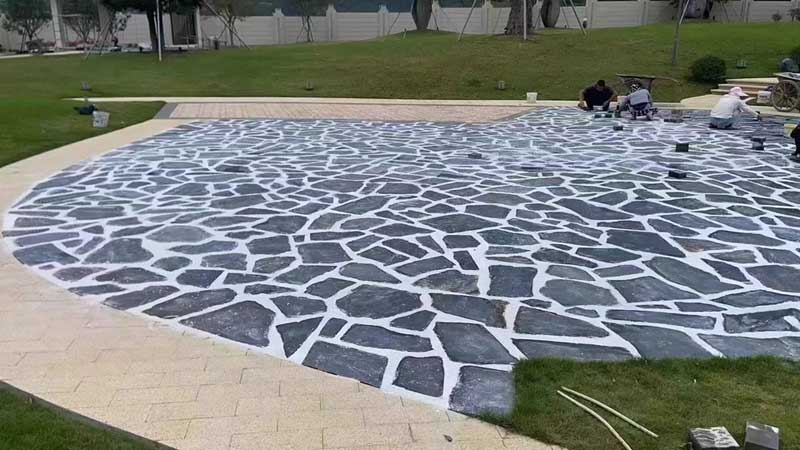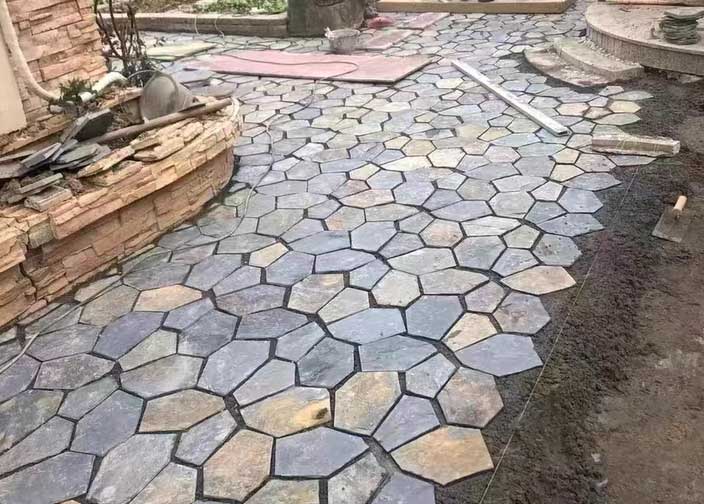Strappato tra il fascino rustico della pietra sciolta e le linee pulite delle pavimentazioni? Non sei solo. Innumerevoli proprietari di case lottano con la selezione dei materiali quando creano spazi esterni che si sentono sia coesivi che accattivanti. L'approccio tipico a un materiale spesso lascia paesaggi a sentirsi piatti, prevedibili e privi di personalità.
I paesaggi di materiale misto offrono la soluzione perfetta fondendo elementi naturali con quelli fabbricati. Combinando strategicamente Pietra sciolta Con finiture, mattoni ed elementi in legno, puoi creare spazi esterni con profondità, consistenza e interesse visivo che è impossibile da ottenere con i progetti a materiali singolo. Queste combinazioni dinamiche non migliorano solo il fascino estetico: ti consentono anche di adattare diverse aree del tuo cortile a funzioni specifiche mantenendo un linguaggio di design unificato. Dalla creazione Drop-morte Gorgeous Pathways che guidano i visitatori attraverso il tuo giardino per costruire transizioni tra stanze esterne, le possibilità sono praticamente illimitate.
L'arte e la scienza dei paesaggi materiali misti
C’è qualcosa di quasi magico in un paesaggio che fonde insieme diversi materiali senza soluzione di continuità. Un percorso che passa dalle pavimentazioni lisce al legno rustico, ai confini dove la pietra incontra il mattone o alle aree dove la ghiaia sciolta scorre accanto a elementi strutturati. Questa armonia di texture non è solo visivamente sbalorditiva: è l'essenza di un paesaggio di materiali misti che crea profondità, interesse e funzionalità negli spazi esterni.
I paesaggi di materiali misti combinano elementi come pietra, pavimentazioni, mattoni e legno per creare spazi esterni visivamente dinamici che offrono sia vantaggi pratici che fascino estetico.
Definizione di paesaggi di materiali misti: un'introduzione
Un materiale misto il paesaggio combina intenzionalmente più elementi: pietra sciolta, Pavers, mattoni e legno: creare un ambiente esterno coeso che è maggiore della somma delle sue parti. Invece di limitare il tuo design a un singolo materiale, questo approccio celebra le caratteristiche uniche che ogni elemento porta sul tavolo.
Se eseguito con pensiero, un paesaggio di materiale misto crea ritmo visivo e flusso. Il contrasto tra i materiali ruvidi e lisci, geometrici e organici, o scuro e leggeri, guida l'occhio attraverso lo spazio mentre si crea “Accoglienti per gli occhi” Momenti che sorprendono e deliziano i visitatori mentre si muovono attraverso il tuo giardino o cortile.
Perché scegliere materiali misti? Estetica, funzionalità e sostenibilità
Al di là del loro fascino visivo, i paesaggi materiali misti offrono vantaggi pratici. Materiali diversi si comportano in modo diverso in condizioni diverse: il legno fornisce calore e fascino naturale, la pietra offre durata e atemporalità, mentre le pavimentazioni offrono precisione e struttura. Combinando strategicamente questi elementi, puoi soddisfare esigenze specifiche in tutto il tuo paesaggio.
La progettazione del paesaggio in materiali misti consente una migliore gestione dell’acqua, con sezioni permeabili per assorbire le precipitazioni accanto a superfici solide che dirigono il flusso dell’acqua. Questo approccio ponderato crea microclimi che supportano la vita vegetale diversificata riducendo al tempo stesso il deflusso e l’erosione: una vittoria sia per l’estetica che per la responsabilità ambientale.
Inoltre, l’utilizzo di materiali misti spesso si rivela più economico, poiché è possibile assegnare materiali di fascia alta ai punti focali utilizzando opzioni più economiche in aree meno importanti.
Confronto delle prestazioni dei materiali nei paesaggi misti
| Proprietà materiale | Pietra sciolta | Finitrici in calcestruzzo | Pietra naturale | Mattone di argilla | Legno trattato |
|---|---|---|---|---|---|
| Costo iniziale ($/mq) | 1-5 | 2-8 | 15-30 | 6-12 | 7-15 |
| Durata della vita (anni) | 10-15 | 25-50 | 50+ | 20-30 | 7-15 |
| Livello di manutenzione | Moderare | Basso | Basso | Basso | Alto |
| Ritenzione del calore | Basso | Alto | Medio | Alto | Basso |
| Permeabilità all'acqua | Alto | Basso/Medio | Basso | Basso | Medio |
| Resistenza allo scivolamento | Medio | Medio/Alto | Variabile | Medio | Basso quando bagnato |
Principi di progettazione: armonia, contrasto ed equilibrio
La creazione di un paesaggio di materiali misti di successo si basa su tre principi fondamentali: armonia, contrasto ed equilibrio. L'armonia deriva dalla ripetizione degli elementi, magari utilizzando la stessa pietra sciolta in più aree per creare un filo coeso. Il contrasto emerge dalla giustapposizione di texture e colori diversi, come l'abbinamento di pavimentazioni lisce con legno grezzo. L'equilibrio garantisce che nessun singolo materiale prevalga a meno che non sia intenzionalmente progettato per farlo.
La tendenza crescente nei progetti sia residenziali che commerciali mostra che i progettisti del paesaggio abbracciano sempre più materiali misti per creare spazi esterni distintivi. Materiali di alta qualità provenienti da fornitori affidabili come Top Source Slate garantiscono che questi progetti mantengano la loro integrità nel tempo Pietra naturale prodotti che costituiscono la spina dorsale di molti progetti di materiali misti.
L'integrazione di giochi d'acqua insieme a materiali misti migliora l'esperienza sensoriale, creando una miscela perfetta di natura e design. Il suono dell'acqua che scorre sulla pietra, riflette elementi in legno o incorniciato da bordi in mattoni aggiunge un'altra dimensione al tuo paesaggio, coinvolgendo molteplici sensi e approfondendo la connessione tra le persone e il loro ambiente esterno.
Guida pratica alla combinazione di pietra sfusa con finitrici, mattoni e legno
Immagina di camminare attraverso un giardino dove le finitrici lisce si trasformano in un rustico sentiero di ciottoli, delimitato da caldi accenti di legno e incorniciato da pietra naturale. Questo non è solo un giardino: è un'avventura tattile che invita all'esplorazione e alla scoperta. Creare questi paesaggi con materiali misti potrebbe sembrare un'arte riservata ai designer professionisti, ma con il giusto approccio chiunque può realizzare questi spazi esterni dinamici.
La combinazione di pietra sciolta con pavimentazioni, mattoni e legno crea paesaggi di grande impatto visivo che bilanciano la bellezza naturale con la funzionalità pratica, consentendo ai proprietari di casa di creare spazi esterni unici che riflettono il loro stile personale.
Creazione di percorsi dinamici: guida passo passo
Il segreto di un percorso di Garden Media mista di successo sta in transizioni ponderate. Inizia mappando il viaggio del tuo percorso: dove inizia e finisce? Quali aree ricevono un forte traffico pedonale e quali sono puramente decorativi? Usa queste informazioni per determinare dove ogni materiale ha più senso.
Per le aree ad alto traffico, considera l'uso di finiture o mattoni solidi come base. Mentre il percorso si curva in sezioni più decorative, inizia a introdurre pietre sciolte. Il punto di transizione è dove accade la magia, creando a “dissolvenza” Effetto aumentando gradualmente la spaziatura tra i pavimenti e il riempimento con ghiaia abbinata o ciottoli.
Quando selezioni i materiali, considera come si relazionano tra loro. Le finitrici in ardesia abbinate alla roccia scura del fiume creano un flusso visivo fluido, mentre i mattoni in terracotta con ciottoli chiari offrono un contrasto drammatico. Ricorda di installare bordi adeguati, siano essi in metallo, plastica o pietra naturale, per evitare che i materiali sciolti migrino dove non dovrebbero.
Integrazione di elementi in legno naturale: ponti, bordi e accenti decorativi
Il legno apporta calore e consistenza organica ai progetti paesaggistici in pietra e legno. Prendi in considerazione passerelle di legno rialzate su sezioni di pietra sciolta per un effetto visivo sorprendente o utilizza traversine di legno come gradini attraverso un'area di ghiaia inclinata. Anche un semplice bordo in legno può incorniciare magnificamente la pietra sciolta, creando definizione e prevenendo la dispersione.
Per un approccio più sottile, incorpora elementi in legno come accenti: pensa ai dischi di cedro parzialmente sommersi nei ciottoli o alle panche di legno di recupero posizionate strategicamente lungo il percorso della finitrice. Questi elementi possono fungere da punti focali e aree di sosta, migliorando al tempo stesso l'atmosfera naturale del tuo paesaggio.
Confronto delle prestazioni dei materiali per applicazioni paesaggistiche miste
| Tipo materiale | Costo iniziale ($/mq) | Complessità di installazione | Durabilità (anni) | Requisiti di manutenzione | Migliori aree di applicazione |
|---|---|---|---|---|---|
| Trucioli di ardesia sciolti | 3-6 | Basso | 10-15 | Moderato (aggiornamento annuale) | Aree decorative, zone di drenaggio |
| Pietra naturale Finitrici | 15-25 | Alto | 50+ | Basso (pulizia occasionale) | Percorsi principali, punti focali |
| Mattone di argilla | 7-12 | Medio | 30-40 | Medio (controllo delle infestanti) | Percorsi tradizionali del giardino, confini |
| Legname di cedro | 8-14 | Medio | 7-10 | Alto (tenuta annuale) | Bordatura, elementi in rilievo |
| Decking composito | 15-30 | Medio | 20-30 | Molto basso (lavaggio occasionale) | Aree di transizione, passerelle |
| Finitrici in calcestruzzo | 5-10 | Medio | 25+ | Basso (tenuta occasionale) | Vie ad alto traffico, cortili |
Soluzioni di drenaggio: garantire longevità e stabilità del materiale
Il successo di un paesaggio di materiali misti dipende spesso da ciò che accade sotto la superficie. Crea una base solida con strati di drenaggio adeguati, in genere iniziando con pietrisco più grande, seguito da ghiaia più fine e infine uno strato di sabbia per pavimentazioni o mattoni. Per le aree con pietre sciolte, garantire una leggera pendenza (circa 1-2%) lontano dalle strutture per evitare ristagni d'acqua.
Incorporate permeable sections within your design to allow water to percolate naturally into the soil. This strategic approach not only prevents runoff but also reduces the risk of material displacement during heavy rain. Consider installing hidden French drains beneath particularly vulnerable sections of your mixed media paths to channel water away effectively.
For projects using Top Source Slate products, their precisely cut stone panels can be installed with minimal spacing to create effective drainage channels while maintaining a clean, professional appearance. Ready-to-ship options from their catalog offer cost-effective solutions for standard applications, while custom orders allow for specific dimensions tailored to unique drainage requirements.
Incorporating small water features alongside your stone and wood elements can transform necessary drainage solutions into design highlights. A simple stone-lined dry creek bed that comes alive during rainfall adds dynamic interest while serving a practical purpose in your landscape design.
Conclusione
Mixing materials in your landscape isn’t just about aesthetics; it’s about crafting an experience. As someone who’s spent years in the stone industry, I’ve seen firsthand how the right combination of textures and materials can transform an ordinary outdoor space into something truly special.
My experience at Top Source Slate has shown me the importance of quality materials. Combining our Pietra naturale Con legno, pavone o mattoni ti consentono di creare paesaggi mozzafiato e durevoli che sostengono la prova del tempo. Si tratta di trovare quel punto debole in cui la funzionalità incontra la bellezza.
In definitiva, progettare un paesaggio di materiale misto è un gioco da ragazzi quando ti concentri sulla creazione di armonia ed equilibrio. Quindi, vai avanti, sperimenta trame diverse e lascia brillare il tuo stile personale. Le possibilità sono infinite!


